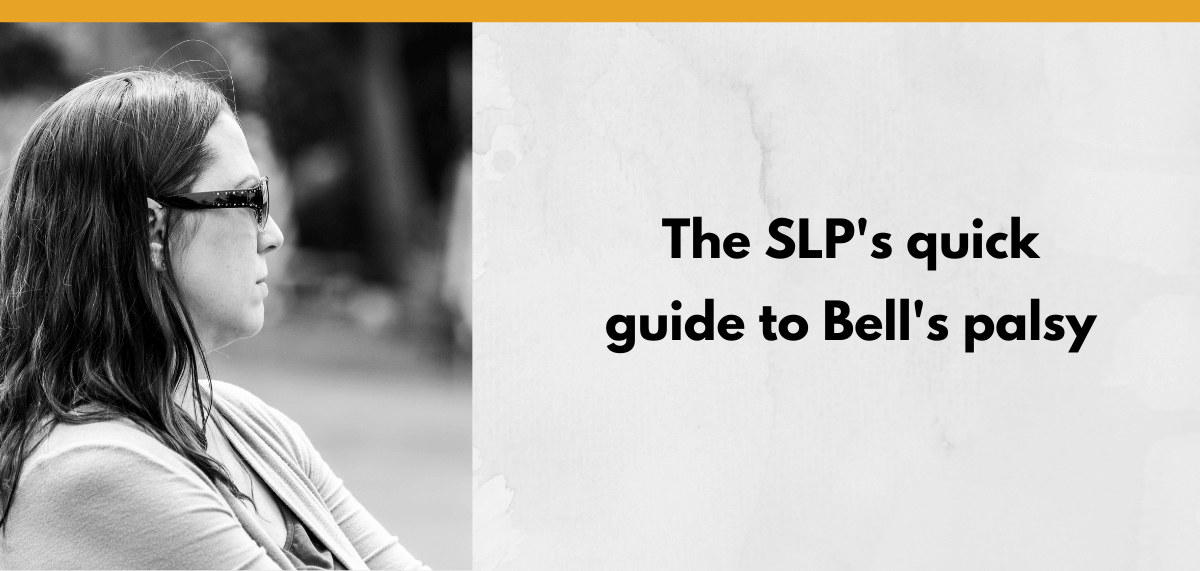Bell’s palsy is a fairly common disorder that is known for causing weakness on one side of the face. Speech-language pathologists are often asked to assess patients with Bell’s palsy, as it generally affects their speech or swallowing. If you’ve been referred such a patient, you may find helpful information here. If you are experiencing facial weakness or other symptoms, seek immediate medical attention.
*Special thanks to a couple of speech-language pathologists who shared suggestions from their personal experience with Bell’s palsy.
Free DIRECT download: Guide to Bell’s palsy (cheat sheet). (Email subscribers get free access to all the resources in the Free Subscription Library.)
Outline:
- What is Bell’s palsy?
- What are the symptoms of Bell’s palsy?
- Is Bell’s palsy permanent?
- Strategies to improve speech.
- Tips to help eating and drinking.
- What are direct treatments for Bell’s palsy?
- Related Eat, Speak, & Think posts.
What is Bell’s palsy?
Bell’s palsy is a non-progressive neuromuscular disorder of the facial nerve (cranial nerve VII). Here are some facts from the National Organization for Rare Disorders:
- Every year, approximately 40,000 people in the US are diagnosed with Bell’s palsy.
- Men and women are equally affected, and it may affect anyone of any age.
- Older people, pregnant women, and those with diabetes or upper respiratory ailments are more likely to be affected.
- The cause is unknown, but may be attributed to viral or immune disorders.
- Symptoms are caused by decreased blood supply to and/or compression of the facial nerve.
What are the symptoms of Bell’s palsy?
The Mayo Clinic shared these common symptoms:
- Unilateral facial droop, which may occur within hours or days.
- Drooling.
- Difficulty closing the eye on the affected side.
- Pain in the jaw or behind the ear on the affected side.
- Heightened sensitivity to sound (hyperacusis) on the affected side.
- Headache.
- Loss of taste in the front 2/3 of the tongue.
- Decrease in tears and saliva production.
Is Bell’s palsy permanent?
Bell’s palsy is usually temporary. Most people start to recover within two to three weeks, and around 80% fully recover within the first three months.
The National Organization for Rare Disorders (NORD) reports that if a patient has some ability to move the affected side of their face, then “a full recovery can be expected”.
NORD reports that there are some possible side effects that may linger. One condition, synkinesis, occurs when nerve fibers connect to different muscles as they heal. Synkinesis results in involuntary contraction of the facial muscles. For instance, the eye may automatically close whenever a person smiles.
Strategies to improve speech
People with Bell’s palsy typically experience slurred or muffled speech with imprecise articulation. They may also have a tendency to bite their lower lip due to decreased movement and sensation.
Here are some compensatory strategies that may help improve speech intelligibility. Different strategies may be more or less effective for different people.
- Exaggerate the movement of the lips on the strong side.
- Open the mouth more to create more space for sound to emerge.
- Pull the affected cheek up towards the ear.
- Increase the volume.
- Decrease the rate of speech.
If the above strategies aren’t sufficient to allow a person to be understood, here are some other strategies:
- Speak face-to-face in good lighting.
- Eliminate background noise.
- Ensure everyone is wearing their glasses and hearing aids, as the case may be.
- Identify the topic of conversation.
If the person with Bell’s palsy still can’t communicate effectively, we can try AAC methods to supplement their verbal speech. For instance:
- Point to the first letter on an alphabet board and repeat the word that wasn’t understood.
- Use writing, typing, or texting.
- Make gestures or point.
- Use an AAC app.
Tips to help eating and drinking
People with Bell’s palsy may have trouble eating and drinking. Specifically, they may have trouble:
- Biting food.
- Chewing.
- Holding food or liquid in their mouth.
Here are some compensatory strategies we may suggest:
- Pull the affected cheek up towards the ear while chewing.
- Use a hand or napkin to help keep the mouth shut while eating or drinking.
- Drink from a straw.
- Use a small diameter straw (coffee stirrers may work best).
- Try placing the straw anywhere from midline to the corner of the mouth on the unaffected side.
- Choose softer foods and add moisture so they aren’t dry.
- Cut the food before putting into mouth, rather trying to bite it off.
What are direct treatments for Bell’s palsy?
Medical interventions may include:
- Oral corticosteroids, especially if started within 72 hours of onset.
- Anti-viral medication.
- Pain medication and moist heat.
- Eye drops, eyeglasses, and/or patches to reduce risk of injury to the affected eye.
According to this 2011 Cochrane review, we have some evidence that rehab can mitigate Bell’s palsy. Treatment for Bell’s palsy should only be provided by trained clinicians to reduce to risks of problems such as co-contracting muscles and synkinesis.
Exercise should not be started in the acute phase. One occupational therapist who specializes in facial nerve rehabilitation shared that she doesn’t start therapy until 3-6 months post onset, in order to reduce the risk of synkinesis and to maximize the degree of spontaneous recovery the patient has.
Trained clinicians may provide:
- Massage to prevent permanent contractures.
- Exercise (if not fully paralyzed).
- Biofeedback (if not fully paralyzed).
- Electrical stimulation (if not fully paralyzed).
- Acupuncture or electrical dry needling.
If our patient has dysphagia, we can refer them to an SLP trained in neuromuscular electrical stimulation (NMES).
If our patient doesn’t have dysphagia, we can refer them to a physical therapist (PT) or occupational therapist (OT) trained in facial neuromuscular rehab.
Related Eat, Speak, and Think posts
- 3 easy ways to sabotage your conversations.
- Free low-tech AAC for adults.
- How to make pureed food taste good.
Free DIRECT download: Guide to Bell’s palsy (cheat sheet). (Email subscribers get free access to all the resources in the Free Subscription Library.)
Feature image by Bryce Carithers from Pexels.
Lisa earned her M.A. in Speech-Language Pathology from the University of Maryland, College Park and her M.A. in Linguistics from the University of California, San Diego.
She participated in research studies with the National Institute on Deafness and other Communication Disorders (NIDCD) and the University of Maryland in the areas of aphasia, Parkinson’s Disease, epilepsy, and fluency disorders.
Lisa has been working as a medical speech-language pathologist since 2008. She has a strong passion for evidence-based assessment and therapy, having earned five ASHA Awards for Professional Participation in Continuing Education.
She launched EatSpeakThink.com in June 2018 to help other clinicians be more successful working in home health, as well as to provide strategies and resources to people living with problems eating, speaking, or thinking.



I have used kinesio taping with 10 year post Bells Palsy patient along with Vital Stim NMES and this was successful. I now have a patient 4 months post with continued facial and eye droop, Would you recommend speech therapy intervention using these modalities? Thank you ! Carolyn McClanahan, MA CCC SL/P
Hi Carolyn,
Thanks for your question! I researched and wrote this guide because I had my first patient with Bell’s palsy in a number of years and wanted to be up-to-date in my treatment. So unfortunately, I can’t answer your question.
For my patient, I offered initial education and training regarding the compensatory strategies above and then referred to an SLP who was trained in NMES.
I’m sorry I can’t be of more assistance!
Lisa
Addendum to email. Physical Therapy assisted with applying the kinesio tape.
Just acquired a client with bells palsy s/p 10 years and most likely with synkinesis.
What is the likelihood NMES would do anything to help at this point.
87 yr old F who has been experiencing more drooling and diff chewing as of lately with moderate dysarthria and dysphagia.
Hi Jamie, thanks so much for the question.
As I’m not trained in NMES, I’m not the right person to ask about potential prognosis for your patient.
Here is an open-access paper from 2023 that reviews the evidence for e-stim for treatment. It sounds like predicting outcomes is challenging, in general… https://pmc.ncbi.nlm.nih.gov/articles/PMC10299525/